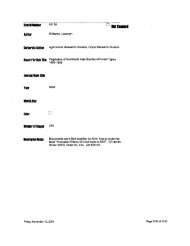Item ID Number - Special Collections
Item ID Number - Special Collections
Item ID Number - Special Collections
You also want an ePaper? Increase the reach of your titles
YUMPU automatically turns print PDFs into web optimized ePapers that Google loves.
-17-<br />
(tetrachlorodihcnzo dinxin). Pure algae cultures were grown on a<br />
dci'initlve raedla under laboratory conditions. The compounds were<br />
studied under the following conditions: (l) growing al|,ao undor 2't<br />
hour light, (2) heat killed algae under 2'* hour light, (3) growing<br />
algae undor total dark (standard mrdia amended with glucose) and<br />
('0 controls (the medium alone but no algae) under ?.h hour light. The<br />
above studies were conducted for 7 days.<br />
Three co-npomids, 2,U-D, 2,U,5-T and TODD were reslstent to breakdown<br />
under those conditions. Mexn.carba.te, and DDT were readily broken<br />
down. Although inexaoarbatc was defended in the presence of light alone,<br />
in the presence of algae (living and dead), over '(0$ of the compound<br />
was converted to water soluble materials not fo^nd in controls. These<br />
compounds became solvent exl.ractable only after acid hydrolysis. A<br />
chloroform soluble metabolite was also dotcc'-ed v/hich was not found in<br />
c ntro.ls. This material had an Rf (ethyl ether, hexane, othanol;<br />
Y7:?0:3) belween methyl fonaami.do and formamldo mexacarbate derivatives.<br />
Tlie degradation of DDT under the above light conditions seem to<br />
give a small amount of DDA. In the presence of algae (living and dead),<br />
under light conditions, two other compounds were formed. One compound<br />
has tentatively been identified as DDE. The other compound using three<br />
TT£ systems has been identified as DDOH. Due to the fact that dead<br />
algae also forms the metabolites of mexacarbate and DDT it is postulated<br />
that a compound is formed by the algae v/hich causes photo-decomposition.<br />
The identification of the metabolites and the nature of the photosensitizers<br />
are proposed for future study.<br />
INDEX OF TECHNICAL REPORTS<br />
1. No Technical Reports have been issued.<br />
BIBLIOGRAPHY OF ALL PUBLICATIONS<br />
1. Batterton, J. C., G. M. Boush and F. Matsuraura. 1972. DDT: Inhibition<br />
of sodium chloride tolerance by the blue-green algae<br />
Anaeystis nidulans. Science 176: llUl-llU3.<br />
2. I'atsumura, F. and H. J. Benezet. 1973• Studies on the bioaccumulation<br />
and microbial degradation of 2,3,7,8-tetrachlorodibenzop-dloxin.<br />
Environ. Health Persp. 5: 253-253.<br />
3. Boush, G. M. . Effects of pesticide terminal metabolites on<br />
algae and brine shrimp. (In preparation).
















